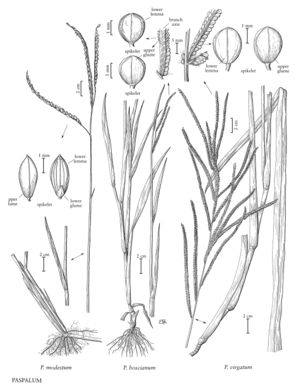Paspalum virgatum
Plants perennial; cespitose. Culms 100-200 cm, stout, erect; nodes glabrous. Sheaths pubescent; ligules 1.9-2.2 mm, brown; blades 30-90 cm long, 1-3 cm wide, flat, glabrous, pubescent behind the ligules. Panicles terminal, with 10-20 racemosely arranged branches; branches 3-15 cm, spreading to diverging; branch axes 1-1.7 mm wide, winged, wings narrower than the central section, terminating in a spikelet. Spikelets 2.2-3.2 mm long, 1.8-2.4 mm wide, paired, appressed to or diverging from the branch axes, obovate, brown. Lower glumes absent; upper glumes and lower lemmas glabrous or variously short pubescent, 5-veined, margins entire; upper florets 2.5-2.7 mm, brown. 2n = 36, 40, 54, 80.
Distribution
Puerto Rico, Virgin Islands, Ala., Ga., Tex.
Discussion
Paspalum virgatum is native from Mexico to South America. It has been introduced to the southeastern United States, where it grows primarily in disturbed areas and cultivated fields.
Selected References
None.
